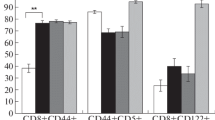Abstract
TheH-2 restriction pattern of cytolytic T lymphocytes (Tc) and T lymphocytes which mediate a delayed-type hypersensitivity response (Td) directed against infectious Sendai virus was investigated usingH-2 mutant mice. Td and Tc lymphocytes exhibit the same fine specificity for self-recognition, for example, B6.C-H- 2bm1 effector T cells were unable to recognize viral antigens in association with wild-type Kb and vice versa, B6.-H- 2bm6 effector cells did not mediate a reaction against virus plus wild-type Kb but, on the other hand, T cells of wild-type Kb recognized virus plus Kbm6.BALB/c-H- 2dm2 T cells lacked reactivity against virus in association with wild-type Dd, but again wild-type Dd effector cells recognized virus plus Ddm2.
Similar content being viewed by others
Abbreviations
- DTH:
-
delayed-type hypersensitivity
- EID50 :
-
mean egg infective dose
- FCS:
-
fetal calf serum
- HAU:
-
hemagglutinating units
- LPS:
-
lipopolysaccharide
- Ly(−) :
-
low amount of Ly antigens
- MHC:
-
major histocompatibility complex
- 2-ME:
-
2-mercaptoethanol
- PBS:
-
phosphate-buffered saline
- Tc:
-
cytolytic T cell
- Td:
-
T cell which mediates a delayed-type hypersensitivity reaction
References
Bailey, D. W., Snell, G. D., and Cheny, M.: Complementation and serological analysis of an H-2 mutant.In A. Lengerová and M. Vojtíšková (eds.):Proceedings of the Symposium of Immunogenetics of the H-2 System, pp. 155–162, Karger, Basel, 1971
Bevan, M. J.: The major histocompatibility complex determines susceptibility to cytotoxic T cells directed against minor histocompatibility antigens.J. Exp. Med. 142: 1349–1364, 1975
Blanden, R. V., Dunlop, M. B. C., Doherty, P. C., Kohn, H. I., and McKenzie, I. F. C.: Effects of fourH-2K mutations on virus-induced antigens recognized by cytotoxic T cells.Immunogenetics 3: 541–548, 1976
Blanden, R. V. and Kees, U.: Cytotoxic T cell responses show more restricted specificity for self than for non-self H-2D coded antigens.J. Exp. Med. 147: 1661–1670, 1978
Ertl, H. C. J., Gerlich, W., and Koszinowski, U.: Detection of antibodies to Sendai virus by enzymelinked immunosorbent assay.J. Immunol. Methods. 28: 163–176, 1979
Gordon, R.D., Simpson, E., and Samelson, L. E.:In vitro cell-mediated immune response to the male specific antigen (H–Y) in mice.J. Exp. Med. 142: 1108–1120, 1975
Hansen, J. H., Cullen, S. E., Melvold, R., Kohn, H. J., Flaherty, L., and Sachs, D. H.: Mutation in a new H-2 associated histocompatibility gene closely linked toH-2D. J. Exp. Med. 145: 1550–1558, 1977
Koszinowski, U. and Ertl, H.: Lysis mediated by T-cells is restricted by H-2 antigens of target cells infected with vaccinia virus.Nature 255: 552–554, 1975
Koszinowski, U., Gething, M. J., and Waterfield, M.: T cell cytotoxicity in the absence of viral protein synthesis in target cells.Nature 267: 160–163, 1977
Koszinowski, U. and Simon, M. M.: Generation of cytotoxic T cellsin vitro. I. Induction conditions of primary and secondary Sendai virus specific cytotoxic T cells.Eur. J. Immunol. 9: 715–722, 1979
Leung, K. N., Ada, G. L., and McKenzie, I. F. C.: The specificity, Ly phenotype and H-2 compatibility requirements of effector cells in DTH responses to murine influenza virus infection.J. Exp. Med. 151: 815–826, 1980
Melief, C. J. M., Schwartz, R. S., Kohn, H. I., and Melvold, R. W.: Dermal histocompatibility and in vitro lymphocyte reactions of three newH-2 mutants.Immunogenetics 2: 337–348, 1975
Melief, C. J. M., Schwartz, R. S., Kohn, H. J., Melvold, R. W., and Dux, A.: Analysis ofH-2 mutants: Cellmediated reactivity of theH-2 be variant with four Z-1 locus mutants and the wild-typeH-2sub.In V. P. Eijvogel, D. Roos, and W. E. Zeijlemaher (eds.):Leucocyte Membrane Determinants Regulating Immune Reactivity, pp. 453–461, Academic Press, New York, 1976
Miller, J. A. F. P., Vadas, M. A., Whitelaw, A., and Gamble, J.: H-2 gene complex restricts transfer of delayed-type hypersensitivity in mice.Proc. Natl. Acad. Sci. U.S.A. 72: 5095–5098, 1975
Nairn, R. and Nathenson, S. G.: Structural studies of the H-2D products of the mouse mutant BALB/cH-2D db and the parental strain BALB/cKh-H-2D d.J. Immunol. 121: 869–871, 1978
Nairn, R., Yamaga, K., and Nathenson, S. G.: Biochemistry of the gene products from murine MHC mutants.Ann. Rev. Genet., in press, 1980
Shearer, G. M., Rehn, J. G., and Garbarino, C. A.: Cell-mediated lympholysis of trinitrophenyl-modified autologous lymphocytes. Effector-cell specificity to modified cell surface components controlled by the H-2K and H-2D serological regions of the murine major histocompatibility complex.J. Exp. Med. 141: 1348–1364, 1975
Simpson, E., Mobraaten, L., Chandler, P., Hetherington, C., Hurme, M., Brumer, C., and Bailey, D.: Crossreactive cytotoxic responses. H-2 restricted are more specific than anti-H-2 responses.J. Exp. Med. 148: 1478–1487, 1978
Zinkernagel, R. M.: H-2 restriction of virus-specific T-cell mediated effector functionsin vivo. II. Adoptive transfer of delayed type hypersensitivity to murine lymphocytic choriomeningitis virus is restricted by the K and D region of H-2.J. Exp. Med. 144: 776–785, 1976a
Zinkernagel, R. M.: H-2 compatibility requirement for virus-specific T cell mediated cytolysis. The H-2K structure is coded by a single cistron delivered by H-2K mutant mice.J. Exp. Med. 143: 437–443, 1976b
Zinkernagel, R. M. and Doherty, P. C.: Immunological surveillance against altered self components by sensitized T lymphocytes in lymphocytic choriomeningitis.Nature 251: 547–548, 1974
Author information
Authors and Affiliations
Rights and permissions
About this article
Cite this article
Ertl, H.C.J. Adoptive transfer of delayed-type hypersensitivity to sendai virus. Immunogenetics 12, 579–586 (1981). https://doi.org/10.1007/BF01561698
Received:
Revised:
Issue Date:
DOI: https://doi.org/10.1007/BF01561698




